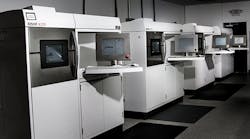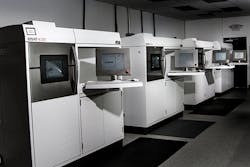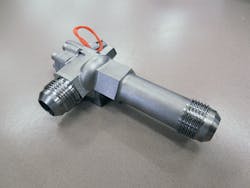Scott Steffan, Deputy Director for Space Access at Moog, earned a B.S. in Mechanical Engineering from Clarkson University, and an M.S. in Mechanical Engineering from Rensselaer Polytechnic Institute (RPI). Starting as a senior structures engineer at United Technologies, then Pratt & Whitney, Steffan performed mechanical design and structural analysis for numerous turbine components and other responsibilities.
He joined Moog in 2001 as a design engineer for their Aircraft Division. Now as deputy business unit director, Steffan provides oversight to engineering and program teams to ensure technical and cost objectives are achieved. Here, he sits for a Q&A with Machine Design Technology Editor Jeff Kerns:
What is Moog’s background in 3D printing?
Steffan: Moog has been investing in 3D metal printing, primarily in the form of additive manufacturing since 2014. We created an Additive Manufacturing Center (AMC) at our headquarters in East Aurora, N.Y., that now has two powder-bed fusion machines and has plans to continue to expand. These machines have been established for specific materials. We are working with titanium, Inconel, aluminum, copper, cobalt chrome, and stainless steel. The most common materials we use for space are aluminum, stainless, and titanium. We are also growing the AMC to be a turnkey center with all necessary pre and post processing capabilities needed to continue technology development.
Why focus on space, and why now?
Steffan: The focus on lower hardware cost and more efficient product development is very strong in the space access, space exploration, and spacecraft markets today. With our investments in the capability over the last years, Moog has already been involved in the development of a large array of space products. 3D printing is beginning to become an integral part of the commercial space industry. It’s used to increase the speed of product development, as well as overall manufacturing lead time.
From a design perspective, it has also opened up new opportunities to improve solutions. The benefits can come in the form of lower recurring cost, lighter weight, and higher performance—offering a higher overall value to customers and partners. Improvements are realized through part-count optimization, material and size optimization, and the ability to manufacture more complex, highly integrated geometries. 3D printing reduces non-recurring costs significantly because there are no special tools or fixtures needed to manufacture the parts.
As for why now, it is tied to the need to create innovative solutions that continue to help accelerate space access and in-space use cases. This goes hand in hand with both growing the commercial space sector and enabling space exploration. We want to be part of the organizations leading this research and development and providing valuable innovative solutions to the industry. Looking at both NASA’s pursuits and commercial interests, it would likely be tough to find companies or engineers that wouldn’t want to be a part of these innovations.
Where does 3D printing come into play when talking about commercial space applications?
These advantages come at a time where the space market is transforming. Commercial and new-space markets are growing, with many new launch vehicle and space companies emerging. These companies are very focused on a fail fast, learn quickly, spiral development model that can benefit from the lead time savings that additive manufacturing brings. For example, we used rapid prototyping to optimize for mass and a 3D-printed enclosure was rapidly prototyped for performance and environmental testing. Later this part transitioned to a vacuum sand cast-aluminum for production, but the quick testing allowed us to test the part and make any changes so we were able to get to a production part faster.
What are the benefits 3D printing brings to designing for space?
Steffan: In addition to the previous benefits is the ability for 3D printing to mitigate the risk of obsolescence issues. 3D printing provides the ability to reconstruct virtually any component geometry through the use of simplified reverse engineering. Existing component geometries can be obtained quickly using scanning and x-ray techniques and efficiently integrated into the additive manufacturing process. This provides the ability to recreate a part without the costs and lead times associated with conventional reverse engineering and remanufacturing techniques.
The real-time nature of 3D printing allows companies to capitalize on ideas while they are still warm, facilitating the ability to do “what-if” type developments quickly and at less cost than in the past.
What does a company need to enter this space?
Steffan: Some of the things that have helped us evolved from years of design, development, and production heritage across a wide range of industries include in-house material expertise for assistance in analysis, and to perform material certifications. The process to design, build, and test space hardware needs to be well understood as tolerances and finishes are imperative. Access to non-destructive inspection capability and associated procedures, as well as the ability for x-ray type scanning capabilities has also been very helpful.



